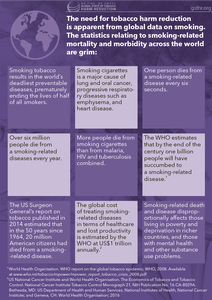The Statistics Relating to Smoking-Related Mortality and Morbidity Across the World
The Statistics Relating to Smoking-Related Mortality and Morbidity Across the World
Knowledge•Action•Change (2018)- No Fire, No Smoke: The Global State of Tobacco Harm Reduction


There are large differences between countries in the overall levels of smoking, and in the levels of smoking between men and women. According to WHO data for 2015, in 26 countries the prevalence of daily smoking amongst men is above 40 percent: in Indonesia, a staggering 65 percent of adult males smoke; 61 percent in East Timor; 57 percent in Tunisia; 51 percent in the Russian Federation and in Kiribati; 48 percent in Syria; 46 percent in Georgia and Armenia, 45 percent in Laos, Greece and Latvia; 44 percent in the Maldives and Egypt; 43 percent in the Solomon Islands and Ukraine; 42 percent in China, Papua New Guinea and Cyprus; 42 percent in Lesotho; 41 percent in Albania and Mongolia; and 40 percent in Bosnia and Herzegovina, Montenegro, Bangladesh, Belarus and Micronesia.
These high levels persist despite major global initiatives led by the WHO to reduce smoking, and despite the investment of billions of dollars in tobacco control to reduce demand and supply.
That smoking has been in decline in much of the developed world is to be welcomed. But the fact that the steep drops since the 1970s have begun to level out in some countries demonstrates that despite all the efforts of tobacco control, even in the West, there are still millions of people who continue to smoke, most notably among the poorest and most vulnerable.
The situation is even more serious in LMIC, where most smoking deaths occur and where population growth is set to increase rather than decrease the smoking population. And it is precisely these poorer countries that simply do not have the resources to make serious inroads into their smoking problem. Overall, at the current levels, the WHO estimated in 2008 that by the end of the century, a billion people would have died from smoking at an annual cost to the global economy of US$1 trillion amounting to a projected total of US$92 trillion by 2100.
Yet there is now a proof of concept which offers a way for governments to tackle smoking-related deaths and disease and move towards the aspirations of the Sustainable Development Agenda, with no drain on national finances. Current safer nicotine products have the potential to replace and eradicate smoking. The history, development and growth in use of these products is the subject of the next chapter.
See also p. 17 of the report: No Fire, No Smoke: The Global State of Tobacco Harm Reduction 2018 — Global State of Tobacco Harm Reduction (gsthr.org)